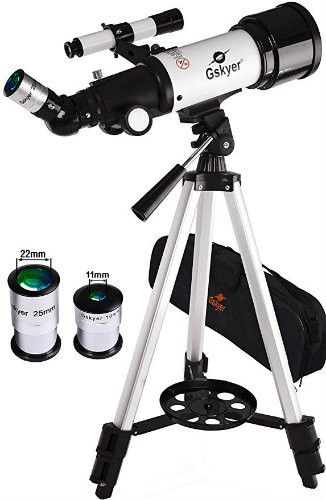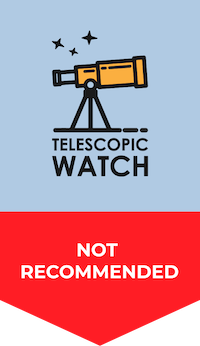
There is a pictorial assembly instruction sheet that does a good job of showing you how to assemble the telescope. But there is no owner’s manual/user’s guide. There are no instructions on how to focus or align the finder scope and there is no information about how to use the scope to view astronomical objects. I checked Gskyer.com to see if there was an online manual, but I couldn’t find it.
It appears to be assumed that the user knows how to use a telescope or will buy a separate guide. Take this into consideration when evaluating the price. Telescopes in this price range from Meade, Celestron, Orion, and others usually include some kind of user guide in the package or online.
The Presence of Useless 45° Diagonal Instead of a 90°
The first feature that caught my attention was the 45 degree diagonal. If you plan to use the scope primarily as a daytime spotting scope or to view objects in the night sky that are below 30 degrees above the horizon, that will work OK. However, viewing targets approximately 40 degrees above the horizon or higher will become awkward and may require the user to kneel on the ground to get low enough to use the eyepiece.
Unfortunately, we would normally give preference to viewing objects between 30 and 90 degrees above the horizon when viewing the sky. So most of the time, the eyepiece will not be in an optimal position for astronomy with this diagonal. Viewing near the zenith, straight up, would be very difficult. This is unfortunate, as viewing near the zenith is an excellent area as the atmosphere is thinnest in that direction, causing less atmospheric distortion. This is why astronomical diagonals, often called star diagonals, are 90 degrees, not 45 degrees.
You could buy a 90 degree diagonal to add to the scope. But that adds to the cost.
Expected Quality Eyepieces
The included eyepieces appear to be of a Kellner-type design, which is to be expected in a package at this price point. While they work well, they lack eyecups to block out stray light. Light from streetlights or your neighbor’s front porch can cause reflections on the lens, which can seriously degrade the image in the eyepiece. I would recommend using a hood over your head when using these eyepieces.
The eyepieces provide 16X and 40X, which are well suited to the scope. When combined with the included 3X barrel, they will provide 48X and 120X. 120X would be about the practical limit of a 70 mm short focal length refractor.
It is normal to add eyepieces to a telescope package after the initial purchase. In the future, you may wish to add one or two eyepieces to fill in the gap between 48X and 120X, as this would be a very useful part of the range of this scope.
The Camera-type Tripod
The tripod is a lightweight camera-type tripod. It is adequate for the weight of the scope.
But where is the slow-motion control that is called out on the Amazon web site? It claims that the tripod has slow motion control, but I found no evidence of this on the tripod and there is no manual to explain this feature.



POS! No Instructions. Does not focus
Correct, no insturctions. However I do provide a first time telescope users’s guide here:
How to Use a Telescope: First Time User’s Guide
https://telescopicwatch.com/telescope-user-guide/
As far as does not focus, use the lowest power, highest number eyepiece first. As you turn the silver dial the diagonal should move out which is how focus is achieved. If it does not move, check underneath, near the focuser knob, for a locking screw. Loosen that screw just enough that the diagonal will move when you turn the focus wheel.
During the day, find a distant target and point the scope at it. As you rotate the silver wheel back and forth to work the focus be aware that you may have to bring the focuser way out before it comes to focus. If the eyepiece does not move, then the focuser is locked.
Give that a try.
Any insight on view through eyepiece?
For example, is there significant chromatic aberration?
Short focal length is typically wide field. How wide is Gskyer fov?
How many elements is 70mm objective lens?
Does objective lens have coatings?
Thnx
There will be chromatic aberration in any achromatic refractor telescope, Gskyer, or any brand. This is most apparent on bright objects. However, I ignore it. I have another 80 mm F5 refractor by Meade and it exhibits a similar amount of CA. It is to be expected.
The field of view will vary by magnification and type of eyepiece. The included eyepieces appear to be Kellner type eyepieces which would suggest a 40-degree apparent field of view.
Focal length scope / Focal length eyepiece = magnification
Apparent field of view eyepiece / magnification with that eyepiece = field of view.
You may want to read my article on Understanding Telescope Eyepieces
https://telescopicwatch.com/best-telescope-eyepieces/
I believe Gskyer claims the objective lens is coated. I presume the objective is a two-element but I did not take it apart. Most achromatic refractors are two-element objectives.
What I bought to be exciting for my grands has turned out to make me look dumb. No real instructions on how to put together or use. Very disappointed.
I agree that the included picture instruction sheet is fine if you know what you are doing but it really isn’t enough for someone who is new to telescopes.
You may want to read my article on How to Use a Telescope: First Time User’s Guide
https://telescopicwatch.com/telescope-user-guide/
This was a big disappointment. It sure looks like a telescope but as the professional review points out the Gskyer is more of a spotting scope – and that is not what I was looking for. I hope that I can return it.
No user manual. Unsure how to use lenses to get distant views.
Have you tried the different eyepieces? If you had you would have seen that one provides more magnification than the other. Simple try and see approach can be very effective. However, lower number eyepieces provde higher magnification.
Understanding Telescope Eyepieces- There are recommendations, based on budget, but the meat of the article is about understanding the considerations and specifications to know when selecting eyepieces.
https://telescopicwatch.com/best-telescope-eyepieces/
How to Use a Telescope: First Time User’s Guide
https://telescopicwatch.com/telescope-user-guide/
It is not the best telescope for astrophotography or deep sky viewing, nonetheless, we have been enjoying it almost daily since we purchased it 7 months ago. You get good views of the moon and large planets, and very decent photographs with the phone adaptor and remote. Sure, there is color aberration, but you can easily make it look better with editing. And you put it together and take it apart in less than a minute. We have taking it to different places and mostly use in the backyard to watch sky objects, but also good for birds and boats on the lake.
Hi Liz,
I assembled my telescope according to the instructions, and everything looks right, but when I try to use it, I only see white (???) . What did I do wrong?
Thanks!
How does the remote work for the cell phone attachment??
It was not tested.
The camera works by turning it on with a switch on the side and then either clicking the iOS or Samsung button so it could connect to Bluetooth and if you have an iPhone you just need to turn it on go to Bluetooth and see a new name then click on it.That’s it.
I found this small scope to work for my particular uses. I watch space launches in Florida with it. I also plan to use it on cruises for viewing things in the distance. It’s also fine for viewing the moon and a lunar eclipse. It’s light weight allows for easy manual tracking.
As stated, it comes with a light weight tripod that I also use it for my camera. It also comes with a compact carry bag that has room for the scope, tripod and accessories. I added a small bag for the lenses. I do find it hard to use with the cell phone mount. I find I get too much vibration to be real useful.
I bought my for $38, used on ebay. I do agree it’s not worth the $100+ the new ones cost. At the price I paid I would not be heart broken if something happened to it.
It’s definitely not a professional grade scope in any way, but it works fine for recreational use. It’s also very portable and light weight, unlike my larger reflector scope, that is very difficult to travel with at all. It would also would work well as training telescope for children. It’s easy to setup and use. That said, it is a very inexpensive portable spotting/moon gazing scope. You get what you pay for!
Great review! I was considering the Gskyer AZ70400 for some casual stargazing and your detailed insights are super helpful. The lack of a user manual is definitely a concern, especially for beginners like me. Do you have any recommendations for good user guides or resources that could help a newbie get started with using telescopes?